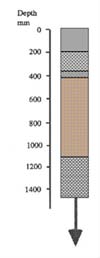Hallam loam
Symbol: Ha
Geology - Silurian sediments or on material derived from these sediments
Landform - Rolling low hills
Soils- This soil is identical to Langwarrin loam but is so named because of its locality which is in the north of the surveyed area. Hallam loam was first described by Holmes et al. (1940).
The surface soil is a grey or light grey loam to silty loam about 150 mm deep. It is likely to set very hard. This overlies a paler grey to brownish grey similarly textured subsoil often with iron concretions just above the subsoil clay. This occurs at about 400 mm to 500 mm and is generally a mottled light brownish grey and yellow-brown medium to heavy clay. On the slopes, weathered rock occurs at a depth of about 1 to 1.5 m.
Typical profile of Toomuc sandy loam
 | 0 - 150 mm. Grey loam or silty loam, clear transition to: 150 - 400 mm. Light grey silty loam to clay loam often with concretions of ironstone just above the clay. clear transition to: 400 mm continuing to decomposing rock. Brownish grey with yellow-brown mottles medium to heavy clay. Red-brown mottles with depth. Decomposing siltstone or mudstone generally occurs before 2m. |
Although this soil is well drained externally, its internal drainage is very slow because of the impermeable clay subsoil. During the wetter parts of the year, the subsurface becomes waterlogged. When wet, the surface soil tends to "run together" and sets hard on drying. The soils here are either unused or used for grazing of cattle and horses.
Similar soils occur on Silurian sediments in the Yarra Valley and north of Pakenham. Here they are used for vineyards, orchards, flower growing and market gardens, mainly winter growing cruciferous crops such as cabbages, cauliflowers and broccoli.


